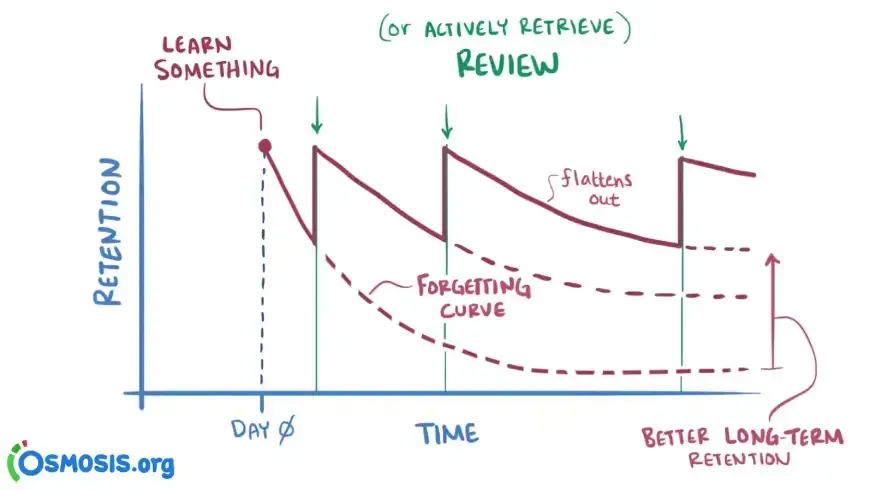Glossary
Source language = your mother tongue
Target language = the language you’re learning
SR = Spaced Repetition
SRS = Spaced Repetition Software (Anki)
AR = Active Recall
Goal
Our goal with this system is to acquire proficiency in our target language, in all 4 areas - Speaking, Listening, Writing, Reading. This is a long-term system, the results curve is an S-curve, where at first, progress will seem slow, then will get faster, and then, somewhere around the C1 level, diminishing returns will kick in, but most people will stop there anyway.
Acquiring proficiency isn’t enough, we also want to maintain it long-term while minimising time investment.
Core ideas
Immersion
Immersion in our context is changing as much of your environment as possible to your target language. This includes:
- Movies
- TV Shows
- Books
- Podcasts
- News
- YouTube
- Short-form content like TikTok, Reels, YouTube Shorts
- Your computer and phone language
- Your communication language with people around you, written and spoken
The idea is to consume as much material as possible in your target language, and also learn to communicate in your target language. This is much more natural and effective than learning individual grammar rules, pronunciation rules or vocabulary blocks.
The important part of immersion is that whenever you come across a word, phrase, collocation you don’t fully understand, you put it into your SRS. Which brings us…
Spaced Repetition System
The idea behind spaced repetition is nicely illustrated in this graph:

The proposition is that there is a certain forgetting curve for each piece of knowledge, and there also exist intervals where if we actively recall (revise) the information at that interval, we smooth out the curve, i.e. remember the information better. How to determine this interval is an open question, we will let Anki, our SRS, do this for us automatically.
Anki is a program that allows us to input some information and remember it forever. Information is presented and reviewed in the form of flashcards, and we use Active Recall while reviewing them. We are first shown the Front of the card, which is a question, that we answer, in our mind or ideally aloud, and then flip the card, check our answer against the back of the card, and tell Anki whether we remembered right or wrong. Anki then automatically adjusts the next interval, i.e. when will the next time we are shown the card be. We do this for every card, every day. This shouldn’t take more than half an hour each day, and the time spent will decrease over time.
Context
The secret sauce to making Spaced Repetition work is creating your own cards. Downloading and trying to learn decks from other people never works, creating your own cards is crucial. This is where immersion comes in. While consuming content in your target language, you come across words you don’t know. You note those down, and later convert them into Anki cards. Then you do the process outlined above, and repeat. Also, you preserve the context in which you first saw the word, which helps learning immensely. This can be done automatically when reading from a Kindle, or manually when watching movies, shows etc. Context can be just the sentence in which the word was used, or also the scene in the movie where it was used.
Multi-modal learning
The best way to learn information is to employ different modes - reading, speaking / listening, writing. With Anki, this is usually reading, hearing the pronunciation and speaking it. The card templates and automatic card creation takes care of this.
Pros and cons of this system
Pros
- Very time-efficient, you won’t spend more than 30 extra minutes a day with this system (because most of the learning will take place by replacing the material you are already consuming with your target language. The 30 extra minutes is just Anki, including creating new cards)
- Long-term oriented, once you acquire some knowledge, you remember it forever thanks to Anki
- Low-maintenance, once you acquire knowledge, you only spend the minimum amount of time to preserve it
- Broad, depending on the material you consume, you will acquire a broad spectrum of vocabulary and grammar, equipping you for a lot of real-life scenarios.
Cons
- Light on speaking. This will be your least-developed area, so you should supplement with speaking to other people on who are at least C1
Getting started
Setting up Anki
- Download Anki here: https://apps.ankiweb.net/
- Read through the manual here.
- Try out the apps on your phone and desktop. Desktop is superior for creating cards.
Finding content in your target language
- Netflix for movies and TV shows. Subtitles are fine, but in your target language only. Eliminate source language completely.
- Spotify for podcasts.
- BBC News for news articles and short videos on YouTube.
Books
- libgen.rs
- Read on Kindle.
Playlists
- Spotify
- Youtube
Now all that is left to do is immerse yourself into the content, note down words you don’t know and their content, create cards and study them, every day. See you at C2 level!